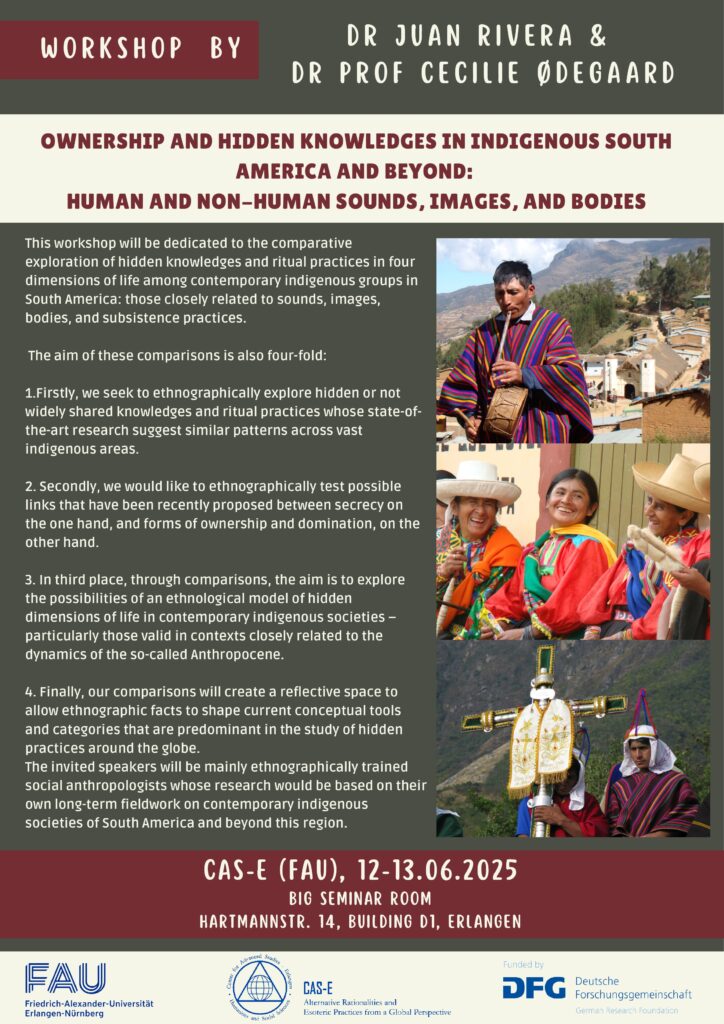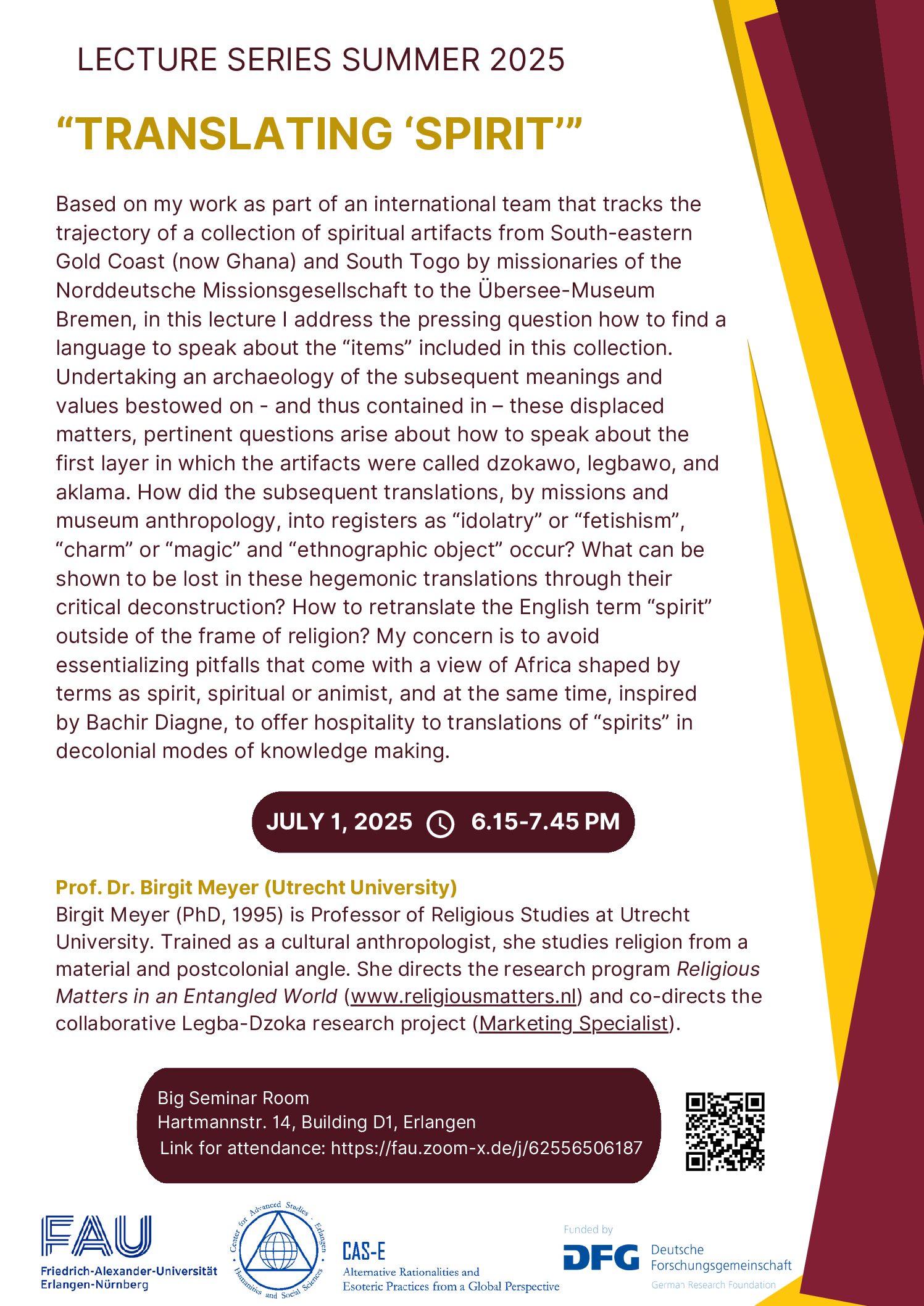Workshop organized by CAS-E Alumnus Dr. Juan Rivera
In collaboration with: Prof. Dr. Cecilie Odegaard (University of Bergen)
June 12–13, 2025, CAS-E, Big Seminar Room in D1, Hartmannstr. 14, Erlangen
For participation and other information: jjriveraandia@gmail.com
This workshop is dedicated to the comparative exploration of hidden knowledges and ritual practices in four dimensions of life among contemporary indigenous groups in South America (and some comparable areas beyond this region): those closely related to sounds (i.e., production of music and other sonic beings), images (i.e., iconography and chromatism), bodies (i.e., rituals and narratives linked to shamanism, healing, witchcraft, and sorcery), and subsistence practices (such as fishing, hunting, agriculture, and herding).

The aim of these comparisons is also four-fold:
- Firstly, we seek to ethnographically explore hidden or not widely shared knowledges and ritual practices whose state-of-the-art research suggest similar patterns across vast indigenous areas (for instance, the use of certain musical instruments and lithic forms in healing practices).
- Secondly, we would like to ethnographically test possible links that have been recently proposed between secrecy on the one hand, and forms of ownership and domination, on the other.1
- In third place, through comparisons, the aim is to explore the possibilities of an ethnological model of hidden dimensions of life in contemporary indigenous societies –particularly those valid in context closely related to the dynamics of the so-called Anthropocene (exploring, for example, how the so-called ontological turn’s premises are transformed when facing settings saturated by extractivism).
- Finally, our comparisons will create a reflective space to allow ethnographic facts to shape (and transform) current conceptual tools and categories that are predominant in the study of hidden practices around the globe (for instance, how the notion of “practitioner” could be influenced by a non-anthropocentric turn in the social sciences, or how Andean versions of cosmopolitanism expressed as “curiosity” could be integrated into a single continuum together with “secrecy”).
The invited speakers will be mainly ethnographically trained social anthropologists whose research would be based on their own long-term fieldwork on contemporary indigenous societies of South America and beyond this region.
Finally, in the mid-term, the outcomes of this workshop would be the publication of a collection of works comparing hidden practices and forms of ownership among indigenous societies (to be submitted to Brill publishing house as part of the series of CAS-E)2.
Participants:
- Valentina Bonifacio, University of Venecia (Italy)
- Julieta Elízaga, Museo Nacional de Historia Natural (Chile)
- Iris Gareis, University of Frankfurt (Germany)
- Sebastien Hachmeyer, University of Hildesheim (Germany) (online)
- Ernst Halbmayer, University of Marburg (Germany)
- Cecilie Ødegaard, University of Bergen (Norway)
- Amy Penfield, University of Bristol (UK)
- Anna Przytomska, Gdańsk University (Poland)
- Juan Rivera, University of San Marcos (Peru)
- Filip Rogalski, Gdańsk University (Poland)
- Frédéric Saumade, University of Aix-Marseille (France)
- Nils Haukeland Vedal, University of Bergen (Norway)
- The relation between secrecy, ownership and authority as “structures of exclusion” has been highlighted in the following way by Graeber & Wengrow: “Even among those foragers groups, famous for their assertive egalitarianism, he [James Woodburn] notes, there was one striking exception to the rule… that individuals should not lay private claim to property. This exception came in the sphere of ritual… initiation… cults [which] form the basis of exclusive claims to ownership, usually of ritual privileges, that stand in absolute contrast to the minimization of exclusive property rights in everyday… life. These various forms of ritual and intellectual property… are generally protected by secrecy… It’s not just relations of command that are strictly confined to sacred contexts… so too is absolute… “private”… property… there turns out to be a profound formal similarity between the notion of private property and the notion of the sacred. Both are, essentially, structures of exclusion”. (2021: 158-159). Additionally, the relation between secrecy and domination is explicitly focused on Amerindian cases: “an important feature in much of the Americas is the relationship between esoteric and bureaucratic knowledge… Over the long term of pre-Columbian history, this particular sort of [esoteric] knowledge always seems to lie at the core of systems of domination” (Graeber & Wengrow 2021: 474-475). ↩︎
- This is the third edition of a series of workshops dedicated to South American ethnography. The first took place in the Netherlands (old premises of NIAs in Wassenaar) and the second one at the College of Fellows
(University of Tübingen, Germany) a few years ago. On the already published outcomes of these past events, please see: https://www.berghahnbooks.com/title/RiveraAndiaNon-Humans https://link.springer.com/book/10.1007/978-3-319-93435-8 ↩︎








